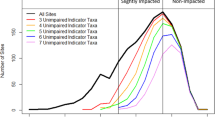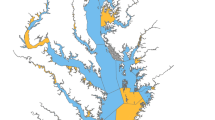Abstract
Budget changes, whether positive or negative, in water quality management agencies often mean a change in resources available for water quality monitoring. Many state agencies are currently facing monitoring budget cuts and, as a result, are reevaluating their monitoring programs. Such evaluations make use of a number of information sources, not the least of which are monitoring activities in other states. This article reports results of a survey of all fifty state water quality monitoring programs. Twenty questions were asked in the general areas of fixed-station monitoring, special studies, and biological monitoring. Each state was contacted by telephone at least twice during the survey. Fixed-station monitoring is conducted by 48 of 50 states. An average of 75 stations per state are sampled, generally on a monthly basis. There is a large variation in the way data are analyzed by the states; water quality indices and plots of concentration or loading over time are the most common methods. All but three states conduct special studies, but only seven repeat the studies on a regular basis. Special studies are generally problem specific as opposed to basin oriented. Biological monitoring is performed by 33 states; however, this is an area in which budget cuts are having a noticeable impact. In some cases, biological monitoring is being completely eliminated or suspended. Macroinvertebrate sampling is performed quarterly to biannualiy by 50% of the states; 75% of the states that sample macroinvertebrates do so annually. Periphyton sampling is performed by 33% of the states. Over 50% of the states are in the process of revising, or have revised, their monitoring program during the past five years. However, only four states had a detailed rationale and operating procedure for the entire monitoring system. Results of the survey are, therefore, averages of existing monitoring programs. Average results do not necessarily represent ideal situations, but do give an indication of how states are coping with their monitoring responsibilities.
Similar content being viewed by others
Literature cited
Anon. Environmental planning guide issue: state environmental protection agencies. Pollution engineering. 1982. January:38–39.
General Accounting Office. 1981. Better monitoring techniques are needed to assess the quality of rivers and streams. Report no. CED-81-30. US General Accounting Office, Washington, DC, April 30.
Loftis, J. C., and R. C. Ward. 1979. Regulatory water quality monitoring networks: statistical and economic considerations. US EPA report no. EPA-600/4/79-055. Las Vegas, NE. 89 pp.
National Academy of Sciences. 1977. Environmental monitoring. Volume 4. Analytical studies for the US Environmental Protection Agency. National Academy of Sciences, Washington, DC.
US Environmental Protection Agency. 1977. Basic water monitoring program. US EPA report no EPA 440/9-76-025. Washington, DC. 51 pp.
Ward, R. C., G. M. Smillie, J. C. Loftis and T. G. Sanders. 1982. Relating stream standards to water quality monitoring practices. Final report for grant no. PRA-7913073. Division of Policy and Research Analysis, National Science Foundation, Washington, DC. January.
Author information
Authors and Affiliations
Rights and permissions
About this article
Cite this article
Perry, J.A., Ward, R.C. & Loftis, J.C. Survey of state water quality monitoring programs. Environmental Management 8, 21–26 (1984). https://doi.org/10.1007/BF01867870
Issue Date:
DOI: https://doi.org/10.1007/BF01867870




